Ok, continuing from Part 1, I want to address two more general issue and then give some examples of how two a day training might be applied to weight training along with a couple of other sports.
Table of Contents
Summarizing Two a Day Training in the Weight Room Part 1
First let me summarize the points I made in Part 1 of this series.
- Two-per-day training is training the same muscles/movements twice a day with an, ideally, 4-6 hour break
- Initially, individual workout duration should be kept at roughly 40-45 minutes. Or you can do one full workout (60 minutes) and one supplemental workout
- The workouts should be divided into heavy and light where the following guidelines apply
- For Growth Training
Heavy Training is anything below 8 reps
Light Training is anything higher than 8 reps (at an appropriate intensity) - For Strength Training:
Heavy training is anything below 5 reps
Light Training is anything that falls under repetition effort or dynamic effort methods
With that out of the way, two more general points and then sample workouts for different sports.
A Note About The Break Between Workouts
As usual I managed to not address a very obvious question that was asked in the comments section of Part 1. Which is this: What if your schedule won’t allow exactly a 4-6 hour break between workouts? Herp de derp on me. Of course this is a situation where idealism and reality crash together which is never pretty.
Some people may be in a situation where they can only train morning and again at lunch. Or lunch and right after work. Or before and again after work. Depending on your schedule this may or may not fall exactly at the 4-6 hour mark.
Don’t stress about this. If you go 7 hours between workouts or only have 3.5 hours between that doesn’t make this approach magically not work. As I mentioned, during my stay in SLC, I regularly had times when I trained on the ice and trained again 2 hours later. It is what it is and do your best to have a sufficient break between workouts. Don’t get hung up on the 4-6 hour break as being some absolute thing. Ok moving on.
Heavy and Light or Light and Heavy
Above I mentioned that, unless you are superman (or Bulgarian, har har), you are going to want to do one heavy and one lighter workout for each muscle group on any given day (recall that in this approach you are training the same muscles in each of the two daily workouts). So a question that comes up is whether or not to do heavy or light first in the day. And the answer is that it depends.
A lot of what it depends on the individual. Some people are kicking and ready to go in the morning and can bust out a heavy workout without a problem. Others are flat as hell, have no strength or pop and will benefit from doing the lighter workout in the morning (it acts as a warm-up/potentiating workout to make the afternoon workout go better).
Non-Bulgarian Olympic lifters frequently use a light/heavy approach where the morning workout is lighter/more explosive (and often different movement, power variations, pulls, squatting) to set them up for a monster workout in the afternoon of heavy competition lifts. The same would apply to powerlifters or other strength athletes, a light priming workout in the morning may do more to set you up for the later workout where you can nuke yourself.
There are other considerations, if you have to train first thing in the morning, it’s often inadvisable to go super heavy. It takes at least an hour to really warm-up after sleep, joints and connective tissues may not be ready for heavy loading, there is even a potential spinal issue as the disks fill with more fluid during sleep and aren’t as resistant to damage. Going in and busting out heavy triples after rolling out of bed is probably not a good idea. Certainly with extensive warm-ups (a hot shower, extra warmup in the weight room) this can be gotten around but not everybody has that kind of time.
But how do you know? The simplest answer is to try both and see which works better but that’s not very helpful. I actually have a method of knowing what’s best for someone but it’s currently still in development. For now I would offer this: if you are really geared towards good strength/power production, and that usually means some amount of talent and ability in the weight room, it also often comes with big highs and lows in performance, you will most likely do better with a light workout in the morning and going heavy in the afternoon.
If you are more of a Hardgainer type (and yes I don’t like to use that word but everyone knows what it means) or would really be better in endurance sports (like me), you can probably bust out a heavy workout in the morning without a problem. But since you likely suck at strength stuff in the first place, that’s ok. Your heavy is a real athlete’s warm-up.
For bodybuilding the above doesn’t really matter. Since the low end of “heavy” for bodybuilders is sets of 5, it’s probably best to go heavy at the first workout and pump it up in the evening. This won’t be universal, some folks who pursue bodybuilding are really frustrated strength athletes who want to look buff and might be better off doing lighter in the morning and heavier in the evening. But since the rep ranges are higher for bodybuilding, a lot of issues that would apply to strength/power performance don’t apply.
In the following I will only indicate work sets, your warm-up approach is between you and your God.
Two a Day Training for Bodybuilders
Since this is the simplest to describe, let’s get this out of the way. I’ve talked in detail about the requirements for muscle growth in a previous series and won’t detail it here. But bodybuilders will basically have two types of workouts for this approach and all that will really change is exercise selection, etc. Note that I’m only picking representative exercises below, I’m not telling you to do those exercises. Make intelligent substitutions to find movements that allow you to hit the target muscle, train progressively and not get hurt.
The first is the heavy workout which means, again, sets of 5-8. How you approach this is up to you but for the heavy workout you’d be looking at something between 5X5 (25 total reps) to 4X6-8 (24-32) reps for a muscle group in the heavy workout. The light workout would range somewhere from 3-4 sets of 10-15. Yes this is on the high end of the 40-60 “optimal” repetition range but that’s fine. So for a leg day you might see something like
While I would not recommend alternate supersetting squat and RDL during the AM workout this can be easily done with leg extensions and leg curls. So do a set of leg extensions, rest 45 seconds, do a set of leg curls, rest 45 seconds, etc. Abs and low back can also be alternated. This keeps the workout shorter and the PM workout shouldn’t take more than 30 minutes tops to complete. Just don’t fall into the trap of “just adding a few things” to make it longer.
Other workouts would look similarly and some of this will depend on what type of split routine you use. For chest/back you might do:
Delts/Arms would be a third potential day although weekly sequencing rapidly becomes a problem to fit everything in and still get a sufficient weekly frequency for each muscle group. It would look like this:
For the lateral raise, I prefer a well built machine to dumbbells especially for the heavier work. Cables are also an option. Performing rear delts on a properly made reverse pec dec is also my preference.
A final option, my preference is actually an upper/lower split. But how would the workouts be structured? The lower body day is no different from what I wrote above. But what about the upper body day?
On the heavy day, I choose lateral raises instead of OHP due to the fact that only trainees with triceps from hell will get anywhere with the overhead press after heavy benching.
If you are familiar with my Generic Bulking Routine this is basically just it split across two workouts for reasons previously discussed. Again, paired exercises can be alternate supersetted for time efficiency but a crowded gym may preclude that. Done as straight sets, this will probably push the limits of a 40 minute workout but that’s fine. You could also rearrange this to legs/back/bis and chest/delts/tris but I’ll leave it to you to work that out. Just apply the principles of volume and exercise selection outlined above and I have faith you can do it.
Of course after each of your bodybuilding workouts, you will want to make sure you eat. We can certainly quibble/argue about the need for optimal pre/intra/post workout nutrition under most conditions but two-a-day training is a different animal and you’ll want to make sure that you’re sufficiently fueled after each workout to make sure you can not only get through the second workout but maintain an optimal growth milieu (man I love that word).
Two a Day Training for Performance Athletes
Ok, so that’s how bodybuilders might approach it. Let me wrap up by looking at how powerlifters (and to a lesser degree Olympic lifters might do it). And just for the hell of it, I’ll look at how other non weight-room sports might do it. Let me mention the heavy and light idea in terms of which workout comes first.
For bodybuilders that meant one thing but for strength/power athletes the meaning is a bit different. I defined Heavy previously as what most would consider maximal effort (ME) or maximal strength work so sets of 5’s and lower with 85% of max or higher in terms of intensity. Light in this context includes repetition effort (RE) work or like 8’s and up along with dynamic effort (DE) work if you do it at all.
I’ll mention again that, while there is some variability, my experience is that good strength/power athletes tend to do best with the lighter workout in the morning and the heavier in the evening. This is NOT universal and don’t hear me saying that it is but as a generality this is true. Sucky strength/power athletes can often go heavy first thing but since their “heavy” is often about the same weight as what good athletes warm-up with it doesn’t matter so much.
What ends up happening is that the light morning workout sort of “tunes” or “potentiates” the evening workout. The key of course is not to wreck yourself in the morning workout so that you’re not exhausted in the evening. You go in, do a short RE/DE workout to get your system clicking (cue blah blah about central nervous system function and go Google ‘post-activation potentiation’ so you can argue about this online) and then you can wreck it in the evening.
The workout EXAMPLES I’m going to give are going to assume that pattern . If you’re the opposite and do the best in the morning, just reverse the workouts and don’t get too hung up on it. This isn’t actually rocket science.
Two a Day Training for Olympic Lifters
I make NO claim to being much of an OL coach. I’ve worked with a few people, have competent technique and know enough about the training patterns to write some ignorant stuff. As I noted before, it’s a fairly common pattern in the modern era for OL’ers to do multiple workouts per day. In the heyday of insane training and drug use, all the workouts were heavy and maximum. Non Bulgarian humans do better with one lighter and one heavier workout and, as above, the lighter workout is typically done in the morning.
Specifics can vary but a typical morning workout would be lighter, higher repetition sets (so 75-85% maybe for sets of maybe triples) and frequently the power movements (power clean, power snatch), pulls and light squats are done. The key as always is to get warmed up, get your groove on (especially for snatch) so that you can kill it in the evening.
On the heavy workout, snatch and clean and jerk could also be worked to maximum singles for lifters in that type of system. And I really want readers to consider that as a very rough example with the training potentially being set up in very different ways.
Some OL’ers have snatch and clean emphasis days, for example. The morning workout might be power snatch, snatch pull and front squat followed by full snatch, snatches from the hang or box and back squats in the evening. The clean and jerk day would be done similarly with power or broken movements in the AM workout and full competition movements in the evening. I think you get the rough idea.
Two-Per-Day Training for Powerlifters
Powerlifters tend to follow fairly standard training patterns and I’m going to assume a basic upper/lower (or Squat/Bench/Deadlift/Assistance Upper) scheme for this. Deadlifts become a problem sometimes since there are different schools of thought about them ranging from training them heavily infrequently to lightly a lot. If you’re tied into one of the systems like Sheiko or whatever where you train all competition movements in every workout, just make adjustments accordingly.
Westside Style Template
Here’s a Westside inspired sort of template that includes dynamic effort (DE), maximum effort (ME) and repetition (RE) work. First a lower body template.
Consider this a very rough template. Some lifters might prefer to do even heavier competition bench in the evening, going for sets of 1-3 at 85-90% instead of sets of 5. Or they would do true ME assistance work.
Your choice of competition squat or assistance exercise for ME work is up to you, strengths/weaknesses and your personal philosophy of training. Until I write the comprehensive 50 part series on exercise selection you’ll have to work it out for yourself to some degree.
Here’s an upper body template:
Again, use this as a rough template. As above, competition bench might be worked in the PM workout for 1-3 reps at 85-90% instead of 3’s to 5’s. True ME effort work (i.e. board press, floor press) might also be chosen.
Coan Style Training
If you’re on more of an old Coan style split with a Squat, Bench, Deadlift and assistance day, you set it up pretty much the same but the days are a little bit more focused.
Once again, everything but the squat is up to the lifter in terms of exercise selection. Just get both quad, hamstring and glute/ham work in there for both workouts. You get the idea.
Here’s a bench focus day.
Again, outside of doing competition bench, the exercise choice is more or less up to the lifter. On the heavy workout, note that a secondary chest exercise or an assistance ME exercise could be done.
Ok, deadlift days get a little bit complicated depending on how often focus do or can deadlift heavily and that can be fairly individual. Some can go heavy or heavy-ish weekly and others can only go truly heavy every other week.
For the morning lighter workout, the primary movement could be deadlift singles at 75-80%, not true speed work but not heavy. Those with an OL background could do cleans or pulls. RDL is a good light pulling movement although it tends to be more assistance or supplemental. This could be followed up by more upper back or trap work and some core.
For the heavy workout, it’s even more problematic depending on how heavily any given individual can go consistently. If you’re really tied into Coan style training, you’ll be cycling your lift intensity towards a peak anyhow. Some might prefer to do heavy ME assistance work to fix weak points. That would be followed up by more upper back, trap, maybe grip and core work.
I could probably write a lot more for powerlifters. For example, those athletes who can go heavy in the morning and lighter in the evening might do competition and assistance/supplemental work in the morning and then nothing but accessory, hypertrophy, GPP, donkey work in the evening.
Of course if you’re using one of those systems where you squat, bench and deadlift at every workout, you’ll have to work it out your own. Do squat, bench, deadlift, overhead press and some arms in the morning for light work and hit it heavily in the evening. Most of the Sheiko, Korte, Smolov types of programs already build in that kind of variety and probably already have it laid out.
Two-Per-Day Training for Performance Athletes
I know I said I wasn’t really going to talk about this and I won’t in any detail but I can’t handle the bitching in the comments if I don’t so I want to at least touch on this. As I said back in Part 1 it was performance athletes, frequently endurance athletes and specifically those in highly technical sports that tended to find that multiple daily workouts were more valuable.
Of course, athletes with a lot of different things to train (think team athletes who need strength, power, speed, endurance, skill) have done this for years but they also tend to have more variety in the week and what they do doesn’t really fall into the concept of what I’m talking about here, training the same muscles, groups, movements at both workouts.
Endurance athletes, runners, were some of the first to find that adding a short second workout (usually an easy AM fasted run) helped them bring up volume, develop their endurance engine even further and reach a new level of performance without burning out. As mentioned, Kenyan runners take this further with 3-4 runs per day on a near daily basis. They’ll do an early easy run, run again 4 hours later, do some quality work in the evening and some run again. It’s maniacal.
I can’t tell you when swimmers started training twice daily but that has been an assumed part of high performance training for decades now and most train morning and evening at least 6 days per week although usually in complex schemes in terms of intensity. Swimming is also unique that the low impact nature and human inefficiency at it means that swimmers can pretty much train all out at every workout if they want. They don’t break like a runner would.
Cyclists, as mentioned haven’t really gotten on that approach due to the sheer length of their rides. It’s one thing for a runner to add 30 minutes of training when his longest run is 2 hours. A cyclist spending 4-6 hours in the saddle isn’t going to add more riding in the morning on top of that. It just isn’t part of the culture or the training structure for the most part.
But what about other sports that are not pure weight room sports but have something else as their primary performance package (i.e. not Ol’ing and PL’ing where the training IS the sport). How do they structure it? Here are a few random examples to consider.
Track Cycling
I’ve written a little bit about track cycling in the past and it’s important to recognize that it’s an odd little sport. It has a variety of different disciplines ranging from short sprint events (taking about 10 seconds to compete) to middle events (the individual kilo takes about 1 minute, the 4km time trial is about 4 minutes) to longer events (taking forever) and some athletes to crossover in what events they compete in.
Pure sprinters tend to train as such and you see a huge focus on strength/power (some of which can be developed in the weight room and some of which can’t) along with technique, tactics, etc. on bike. The AIS Track Cycling sprint team is informative in this regard as they use a pattern where they do, most days:
AIS Track Cycling
AM: A 2-3 hour weight room workout. This includes pure strength work along with power and core work. This is cycled throughout the year as the focus changes from strength to power to power endurance.
PM: Bike work. This is mostly speed/sprint work along with standing starts (a massively high-force activity).
For about half of the year, when the weight room is being emphasized, they don’t actually care that it wrecks the athletes for the bike. The goal is to get strong as hell and bike work is just to maintain technique. When the focus is on-bike they dial back the weight room work to maintenance/easier levels and the bike work becomes all out speed work.
To that they tack on 6-8 weeks of interval/speed endurance work before competitions. Speed on the bike is a combination of strength, power and leg speed and is hard to develop. Endurance is relatively easy and they do that at the end.
British Track Cycling
In recent years British track cycling has taken over the world and they approach things a bit differently. Changes in the competition schedule and rounds mandate a larger aerobic engine and the typical pattern for British track cyclists is this
AM: 1 Hour Easy Aerobic bike ride (build the aerobic engine, keep the athletes lean, most cyclists like riding)
PM: Track work and weight room work
That’s done perhaps 3-4 days/week with just aerobic recovery rides on the off days. I imagine they cycle the focus of the bike or weight room depending on the season but not a lot of information is available.
Let me make a quick note here which is that, so far as I can tell, track running sprinters NEVER do the above with weights in the morning and sprinting in the evening. Even a small amount of fatigue from lifting/jumping in a morning workout can have disastrous effects on sprint technique and injury risks (in a way that cycling does not). A tiny mis-step and you end a sprinting career. On the bike, that just doesn’t happen and that explains the difference.
Throwing
Throwing training (and here I mean shotput, hammer, javelin) at least ala Bondarchuk (arguably the best throwing coach in history) tends to follow a similar schema where the goal is throw and lift and throw and lift and throw and lift.
The sport has minimal biomotor capacities and you need to practice throwing while developing incrementally greater levels of strength, power, etc. So AM you throw and then lift. PM you throw and then lift. And you do it again with changes in the weight of the implement, the weight movements and loading being used, etc.
My Speed Skating Schedule
Let me finish by describing how my coach trained us for speed skating. Now, I can’t tell you if the schedule that we used during my incarceration in Salt Lake City was typical or not but it was what my coach successfully used for a couple of decades.
Speed skating is a weird-assed sport where it is actually difficult to develop a lot of aspects of performance (such as aerobic engine) on the ice. You have to do it with supplemental work.
As I’ve mentioned, we often didn’t have a long break between skating workouts (which had to be done under rested conditions) and conditioning workouts. So AM and PM aren’t quite accurate here and it’s more of a Workout 1/Workout 2. We also had a situation where we didn’t have ice for a big chunk of the year and that’s when we did dryland training.
Summer/Dryland Training
This was a typical week of summer training.
The main thing to take away from this is that the individual days have a semi-coherent focus. Monday and Friday are more power/explosive days with the jumping and weights while Wednesday and Saturday are more endurance oriented with the inline work and bike riding. This ensures that any adaptational “signal” being sent by the workouts were complementary and overlapping.
Here was a sample week of training on the ice.
Once again you can see that the individual days have complimentary workouts. Monday is starts and sprints on the ice along with weights in the evening. Wednesday was starts, intervals or tempo work (occasionally) laps followed by an endurance or HIIT workout in the evening.
Thursday was either a sprint workout or race prep if we had time trials on Saturday. That was followed by maintenance/power weights. Saturday was either time trials (2 races total) followed by laps or an endurance workout followed by an endurance bike ride.
Mind you, the specific focus of all of the workouts was changing throughout the year and season. Bike rides got longer or more intense, the duration of intervals both on and off the ice changed, weight room work started with higher reps and moved down, etc.
I mainly showed this just to illustrate a real world way of how all of this can fit together.
Similar Posts:
- Combining Weight and Endurance Training for a Marathon
- Two a Day Training in the Weight Room
- Heavy/Light/Medium Training
- Active Rest vs Passive Rest
- Returning From My Layoff

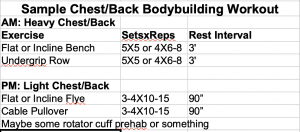
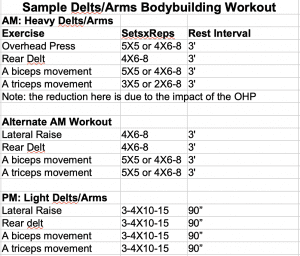


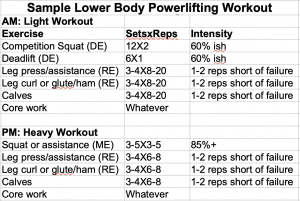
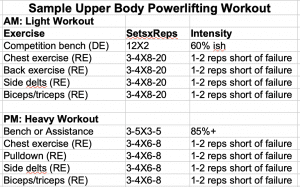
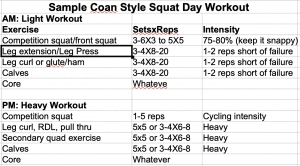


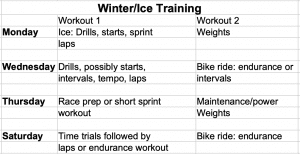
Lyle, I realize this is still in the works, but how would a 8-10 hour break between workouts compare?
Since most of us have 8 hours per day jobs, would a regimen of a morning session followed by a night session after work elicit similar benefits?
Ah, I forgot address this specifically but, as a generality, when idealism and reality crash together it’s never pretty. Some may be forced to do early AM/lunch, lunch/PM or AM/PM. 4-6 hours is ideal. It’s not the only option.
I think that effort or RPE guidelines would be a lot more appropriate in this context. I would like to know what your thoughts are on that. I’ve only found two a days to work with a maximum of one RPE 10 set in a given day, anything else is too much.
So like one heavy workout per day, then. Huh, that sounds familiar somehow.
When I’ve implemented 2 a day’s in the past, I’ve always picked one main movement for rhe first workout and just did that, training it for strength. The 2nd workout was the assistance or pumpy type stuff for the main lift. So it might be conventional deads using 5/3/1 or ramping up and hitting a certain number of singles at or above 90% (prilepin type stuff) and then coming back at night and hitting GHR’s or back extensions, single leg stuff, leg press or whatever else for sets of 8-15. I’ve really enjoyed this set up when I’ve done it because, psychologically, I hate having to warm-up, then do specific warm ups for the main lift, then taking the long rest periods between work sets, being 40 min in at that point, all the while knowing I’m facing 4 or 5 other exercises after that. It’s easier to come back later, not having to go through an elaborate warmup, the ramp up sets, etc and just go right to it with lighter weights and get some volume in for a half hour or whatever.
You guys just can’t wait until Part 3 can you?
No we can’t. Your articles are gospel.
Lyle, post the 3rd part or I’ll kill you!
Amazing article, but i’ve got the same problem of working an 8 hour day, surely 2 hrs wont make that much difference as long as you’re putting the time in?
[WORDPRESS HASHCASH] The poster sent us ‘1762401312 which is not a hashcash value.